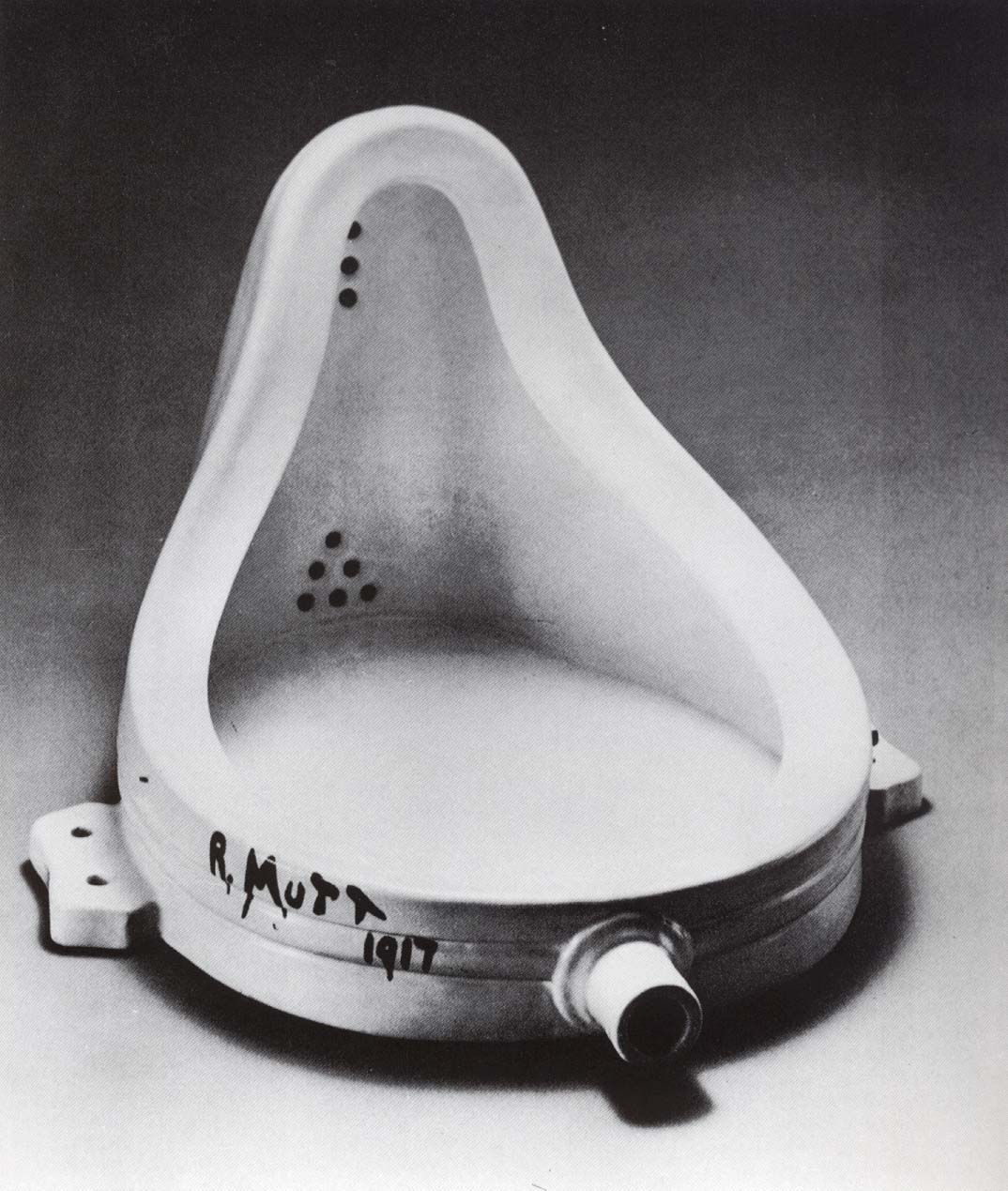phydmn
Posts by :
2018
Kurser på Folkeuniversitetet, efterår/vinter: “KUNSTHISTORIE – rundt om kunsthistorien (august)” – “KUNSTHISTORIE – International og dansk samtidskunst“, med gæstekunstner Franziska Hoppe – “KUNSTHISTORIE – Grundmodul 4: Fra modernismen til samtidskunsten (1920-2017)” – “KUNSTHISTORIE – Dansk kunst i det 20. århundrede“, med gæstekunstner Henrik Plenge Jakobsen – Weekend-kursus, Emdrup, Leonardo da Vinci – Planlagte kurser i 2019:”KUNSTHISTORIE – Rundt om kunsthistorien (januar)” – “KUNSTHISTORIE – Bauhaus 100 år (1919-1933): Arkitektur, kunst og kunsthåndværk“
2018
Øvrige kurser og foredrag: Sønderborg, kursus “Fra romantik til modernisme” m. Ann-Sophie Fischer-Hansen – Århus, foredrag om ekspressionismen – Odense, foredrag om Andy Warhol – Viborg, tre foredrag: “Leonardo da Vinci”, “Van Gogh postimpressionismen” samt “Salvador Dali og Marcel Duchamp”.
2018
Kurser, forår/sommer: “Van Gogh og postimpressionismen” – “Salvador Dali og surrealismen” – “Fra modernismen til samtidskunsten” – “Fra romantik til modernisme” m. Ann-Sophie Fischer-Hansen – “Kunsthistorie, ny dansk kunst”
2017
Kurser på Folkeuniversitetet I København, efterår & vinter: “van Gogh og postimpressionismen”, “Russisk og europæisk konstruktivisme”, “Land art”, “Tysk kunst: Fra die Brücke til Gerhard Richter”, “Fra modernismen til samtidskunsten (1920-2017)”, “Perspektiv, farvelære og det gyldne snit”. 4 foredrag om Asger Jorn, LOF i Holbæk. Foredrag om Marcel Duchamp, Folkeuniversitetet i Herning. Foredrag om Jeckson Pollock, Folkeuniversitetet i Herning. Foredrag om Dansk kunst 1890- 1930, Rebild Centret, Skørping.
2017
Kursus på Folkeuniversitetet i København og Museet for Samtidskunst i Roskilde om “Bauhaus 1919 – 1933“.
Grundkursus på Folkeuniversitetet i København om “Modernisme til Samtidskunst“.
Kursus på Folkeuniversitetet i København og Nivaagaard om “International modernisme – fra realisme til surrealisme“ (med cand. mag. Merete Mørup).
Kursus på Folkeuniversitetet i København og Nivaagaard om “Dansk kunst i det 20. århundrede“.
Kursus på Folkeuniversitetet i Emdrup om “Store danske kunstnere i det 20. århundrede – fra Willumsen til Superflex“.
Vinterkursus i januar om “International og dansk samtidskunst“.
The anamorphosis
The anamorphosis
Version 2, May 2011 (Former version with same text was originally published on artborder.com. That site is now deleted).
An anamorphosis is a distorted picture of perspective, which does not seem normal until it is seen from a specific visual angle. Generally anamorphosis are separated into different groups – usually two groups. At first there are the optical – also called direct or oblique – anamorphosis, which can be seen directly from a specific point of view without any kind of assisting apparatus. For the second there are the so-called catoptric anamorphosis, often called mirror anamorphosis. The latter have to be viewed by the assistance of a mirror of some kind, most often cylinder or cone shaped. According to Jurgis Baltrusaitis – the author of the legendary book Anamorphic Art – the very name anamorphosis does not appear until the 17th Century, but the name was fixed to a phenomenon already known. In Leonardo da Vinci\’s Codex Atlanticus (1483-1518), the oldest known examples of anamorphosis is to be found, but it was only in the 16th Century that the skill was spread seriously.
In the 17th Century the anamorphosis had a revival (note 1). The anamorphosis belongs to the mathematical science of perspective. This science developed in Italy on the threshold of the renaissance (about 1420), when it became a tool for the artists. With the help of the new skill they could (practically) transform the three-dimensional world into two dimensions in a very rational manner – and the correctness could be tested. The picture space of the early renaissance was constructed in accordance with a strict frontal view, and first little by little the artists succeeded in constructing more advanced perspectives. But the most important aspect of the discovery of perspective was probably, that the artists at home in their studios fictively could construct an expiration of space in their pictures. In spite of everything the method had its limitations. It demanded that the distance between eye and picture plane was sufficiently large. If it was not, the picture became distorted or deranged. Marianne Marcussen and Birgitte Bøggild Johannsen give the following description of the anamorphosis: In fact, in its original form the anamorphosis is identical with a rendering of linear perspective, constructed with a very short distance between picture plane and eye. (Note 2) . It turned out however, that the problem could be reinterpreted. In stead of being a problem the distortion became that marvel which in time got the name anamorphosis. I will later return to the construction of the anamorphosis, its technique and function, but not until the following example has been introduced.
Without doubt the most famous anamorphosis must be the one which is to be found on the German artist Hans Holbein the younger\’s breathtaking painting The Ambassadors from 1533 (National Gallery of Art, London):
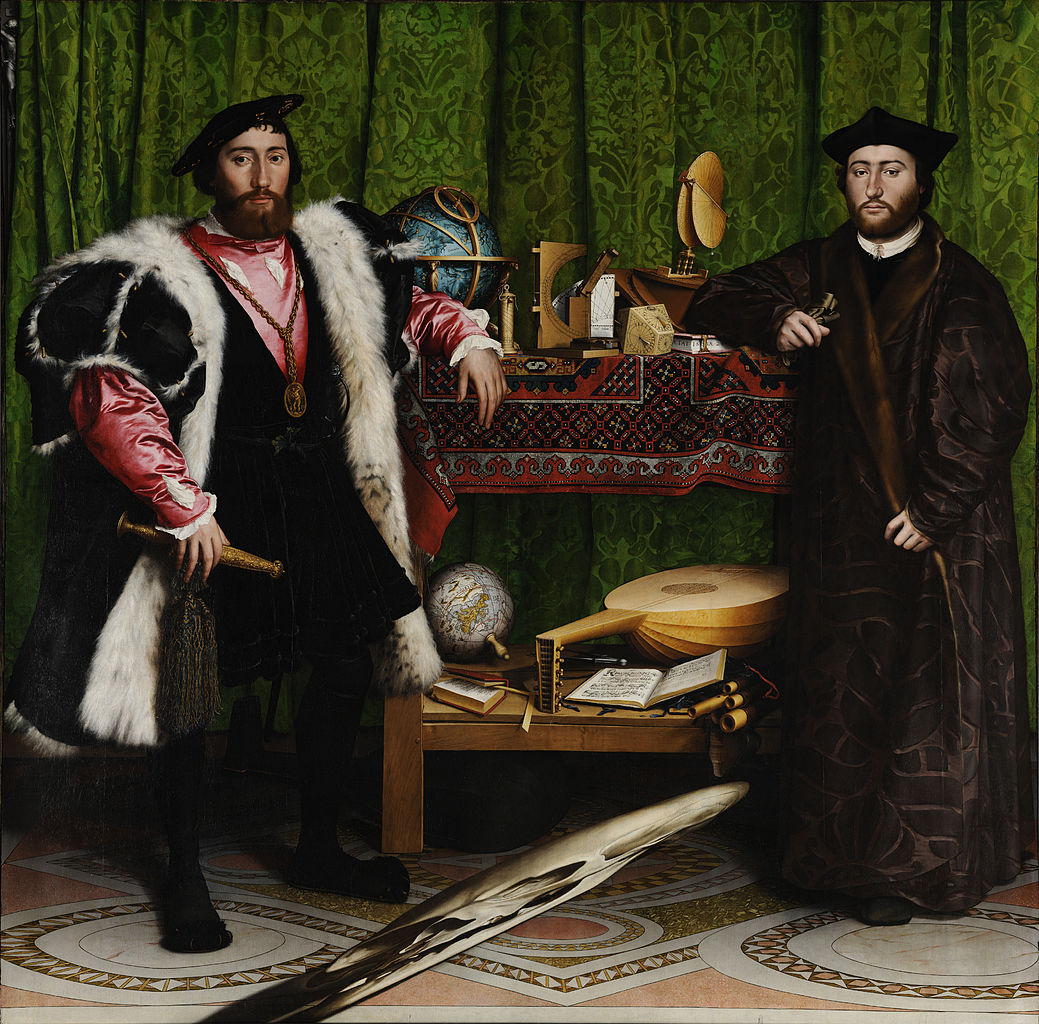
On the lower part of the painting – on the floor – a strange oblique and indeterminable form is to be seen. It is an optical anamorphosis. If it is viewed from a traditional frontal angle you will only see a strange flat and abstract pattern which seems to fix itself to the surface of the painting, to the picture plane. The flat construction of the anamorphosis prevents the beholders gaze in going through the picture plane and out into the illusory picture space as the gaze does on other parts of the painting?s surface.The experience is especially effective here because the rest of Holbein\’s painting of the Ambassadors in a very convincing manner seems to open up to a three-dimensional space behind the two-dimensional picture plane. This impact was achieved by Holbein by erasing any trace of brushwork from the surface of his painting by which the fictive space behind the picture plane untroubled can extend itself. Now, if you step aside to the right and move close to the wall and you turn your gaze towards the edge of the painting in a certain angle the apparent abstract pattern will shrink and form a normal picture of a skull. In fact this picture will appear with an extraordinary lively three-dimensionality – almost like a hologram – as if you could reach into a real space and grasp the skull. Please view a photography of the anamorphosis from the correct visual angle. The reader should notice that the above mentioned effect can not be expressed in photograph since the picture thereby has been fixed to a plane. The reason why the skull is seen so holographic or authentically three-dimensional when viewed from the correct visual angle is because of the fact that the beholder sees a picture which has no picture plane in a traditional manner. The picture of the normal skull exists in a manner of speaking only in the gaze of the beholder. The rest of the painting does not display this effect in the same way in spite of the fact that it also has a convincingly realistic expression.
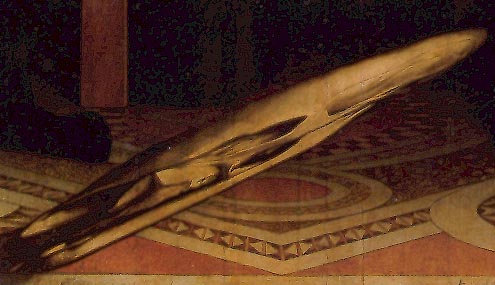
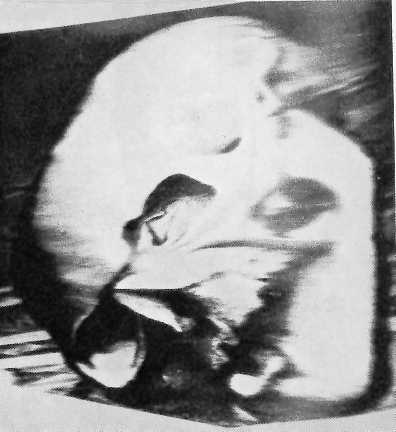
It is recommended that the reader goes to National Gallery in London where Holbein\’s painting is to be found. However, you do not need the original painting to experience the effect. A reproduction – best in color and on shiny paper – can be a substitute. You can find one on the cover of Jacques Lacan\’s book The Four Fundamental Concepts of Psycho-Analysis. Naturally, it is not without reason that Holbein\’s painting decorate the cover of Lacan\’s book. Lacan has as well as I studied the anamorphosis in relation to the gaze. However I will not go into further discussion concerning Lacan and his studies of the anamorphosis here but the book is – in relation to the question of the anamorphosis – usable in several ways. Grab the book by the back and place it at some distance from your eyes at a right angle. The right side of the book must turn towards the nose. You can move the book a little until the construction of the anamorphosis shrinks and unmask the normal picture of the skull. If you do not have a copy of Lacan\’s book you can use any other reproduction of the painting. On Holbein\’s painting two different constructions of perspective has been joint together: The big ordinary picture of perspective constitutes the basis on which the small anamorphic construction is added. But how is the latter made? Probably Holbein has used a classical squared pavement or grid which he has transformed by the means of a distance-point method.
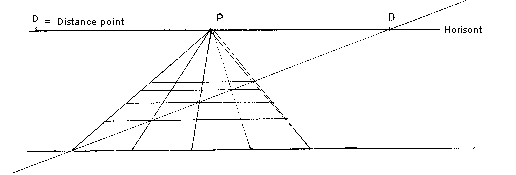
If the distance is made very short – as mentioned before – the squared pavement will look unnaturally distorted. At the same time as the tiles are being distorted an inlaid drawing of a skull will be distorted as well. Holbein must at first have made a sketch of the anamorphosis which afterwards could be included in the normal painting. In its starting point the anamorphosis is situated on a horisontal level but in its position in the finished painting it seems to have been raised into a vertical position. This displacement of dimensions has the result that the beholder has to look for alternative displaced viewing positions in relation to the traditional frontal appeal of the painting. That is if she wants the distorted part of the anamorphosis to shrink and reveal the second part of the anamorphosis – which is the recognizable one. Exactly this ambiguousness is the most fascinating part of the anamorphosis. It is divided into two different acts, and it manipulates the beholder. It can be seen as some sort of organism which like a muscle can stretch and shrink again. In front of the anamorphosis the gaze of the beholder is being divided.
The first gaze sees the flat, abstract pattern which seems to float on the surface of the painting, on the picture plane. It looks at something which manifests itself clearly as a form, but at the same time it is a blockade, which hides the content or meaning. On the other hand the second gaze sees a content, which is an extremely realistic three-dimensional skull, but really not any form because this picture does only exist in the mind of the beholder. In fact the anamorphosis deconstructs the painting by splitting itself into something twice-phased. It acts between being and illusion, between form and content, and between surface and depth. Hereby it tricks the beholder which is not used to this paradoxical ambiguousness. The latter aspects of the anamorphosis can be seen in relation to the development of art in the 20th Century. In this century two opposed art forms – abstract painting and the ready-made – saw the light of day. In my book \”Det dekonstruerede Maleri\” I argue that Duchamp – who himself mastered the difficult technique of anamorphosis – was inspired by perspective, stereoscopy and anamorphosis.
Please read my article about that at toutfait.com (Danish version)
Litterature:
- Jurgis Baltrusaitis: Anamorphic Art, Chadwyck-Healey Ltd, Cambridge 1977
- Hans Hamngren: Anamorfoser, Sveriges Allmänna Konstforening, Stockholm 1997
- Pia Høy: Det dekonstruerede maleri. Marcel Duchamps Étant donnés, Forlaget politisk revy, København 2001
- Jacques Lacan: The Four Fundamental Concepts of Phycho-Analysis, Penguin Books, London 1994
- Martin Kemp: The Science of Art. Optical Themes in Western Art From Brunelleschi to Seurat, Yale University Press, New Haven and London 1990
- Marianne Marcussen og Birgitte Bøggild Johannsen: Rumopfattelse og rumgengivelse i vesteuropæisk naturvidenskab og kunst, København 1979.
Note1: Op.cit., p. 3, p. 28 and p. 33, plus in Kemp, p. 210.
Return to text with link to note 1
Note 2: In Rumopfattelse og rumgengivelse i vesteuropæisk naturvidenskab og kunst, p. 67.
Return to text with link to note 2
2016
Weekend i Århus om Store malere og deres teorier. Weekennd i Odense om Det 20. århundredes kunst.
Kurser i København i foråret, bl.a. i “Van Gogh og Postimpressionismen”, “Store malere og deres teorier – fra renæssancen til Asger Jorn“. Kursus om “Bauhaus” på Nivaagaard, kursus i “Kunst og Provokation” ligeledes på Nivaagaard, kursus om “Dansk kunst i det 20. århundrede” på Museet for Samtidskunst i Roskilde.
2009-2016
2009-2016: Studierejser til bl. Berlin, London, München, Stockholm og Italien (Rom, Firenze, Siena, Assisi, Milano, Padua m.v.). Rejse til Nice og sydfrankrig.
